![]()
![]()
![]()
Use LEFT and RIGHT arrow keys to navigate between flashcards;
Use UP and DOWN arrow keys to flip the card;
H to show hint;
A reads text to speech;
16 Cards in this Set
- Front
- Back
|
What is the definition of an angle?
|
An angle is a geometric figure formed by two rays that have a common endpoint.
|
|
|
What is the definition of a circle?
|
A circle is the set of all points (or locus of points) in a plane that are a fixed distance (the radius) from a fixed point (the center)
|
|
|
What is the definition of perpindicular lines?
|
Perpindicular lines are two lines that intersect to form right angles.
|
|
|
What is the definition of parallel lines?
|
Parallel lines are two or more co-planar lines that do not intersect.
|
|
|
What is the definition of a line segment?
|
Given any two points A and B, line segment AB is equal to the union of points, A, B, and all of those points between A and B
|
|
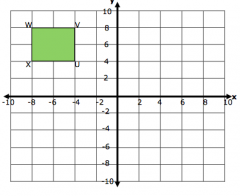
Graph the image of rectangle UVWX after a rotation 180d counter-clockwise around the origin.
|
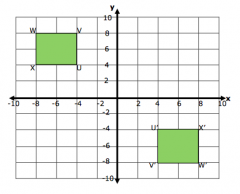
|
|

What will the coordinates of the vertices of ∆XYZ be after a translation 5 units left and 5 units up?
|
X' (-1,3) Y' (-1,1) Z' (-3,1)
|
|
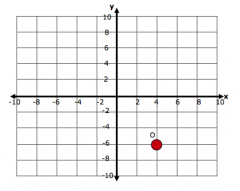
Graph the image of O(4,-6) after a translation 5 units left.
|
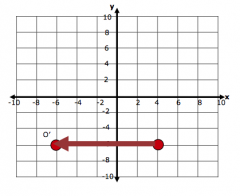
|
|
|
What is the difference between a translation and a stretch?
|
A translation preserves angle and distance while a stretch does not.
|
|
|
Jennifer draws rectangle ABCD as seen here. Find all rotations and reflections that carry retangle ABCD onto itself.
|
Since ABCD is a rectangle, the line through the midpoints P and Q of the respective sides AB and CD is perpindicular to both AD and BC. Since A and B are equidistant from P, reflection across L interchanges A and B, and similarly for C and D. Thus the reflection also interchanges the rectangle edges AD and BC, and leaves fixed the edges AB and CD, so preserves the entire rectangle. The same applies for the perpindicular bisector of BC. In addition to these two reflections, a rotation by 180° around the intersection of L and M (the center of the rectangle) preserves the rectangle.
|
|
|
Jennifer draws rectangle ABCD as seen here. Lisa draws a different rectangle and she finds a larger number of symmetries for her rectangle than Jennifer did for hers. What can you conclude about Lisa's rectangle? Explain.
|
Lisa's rectangle must also be a square because it would have reflection symmetry over the diagonal AC, where Jennifer's rectangle did not have that symmetry,
|
|
|
A reflection is defined in a math book as "the reflection rL about a line L takes each point P on line L to itself and takes each point Q not on L to the point rL(Q) such that L is the perpindicular bisector of QrL(Q). A student who finds this definition confusing says, "the reflection about a line L sends each point to its mirror image on the other side of L." In what ways is the student's definition more helpful than the one from the math book?
|
The student's definition of a reflection is more helpful when trying to visualize the impact of a reflection because it links the geometric notion of reflection to a common every day experience. Also, when comparing reflections to mirror image, we can visualize one of the most important properties of reflections: the switching of notions of left and right.
|
|
|
A reflection is defined in a math book as "the reflection rL about a line L takes each point P on line L to itself and takes each point Q not on L to the point rL(Q) such that L is the perpindicular bisector of QrL(Q). A student who finds this definition confusing says, "the reflection about a line L sends each point to its mirror image on the other side of L." In what ways is the math book's definition more helpful than the student's definition?
|
The math book's definition makes it clear that reflections separate the plane into two pieces. It also makes it clear that for P not on L if rL(P)=Q, then rL(Q)=P (in other words, the reflection interchanges pairs of points). Finally, the math book definition allows us to study the properties of reflections in more depth, such as preservation of distance, composing reflections, etc.
|
|
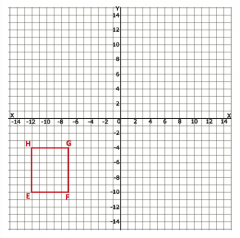
Graph the image of EFGH after the following glide reflection: Translation (x,y)-> (x+2,y) Reflection across the x-axis.
|
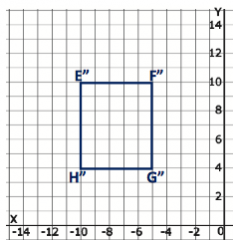
|
|
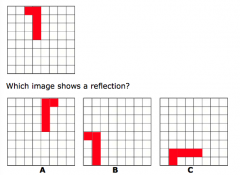
Which image shows a reflection?
|
image A
|
|
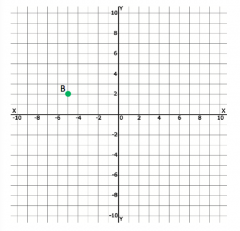
Graph the image of B (-5,2) after a rotation 180d counterclockwise about the origin.
|

|

